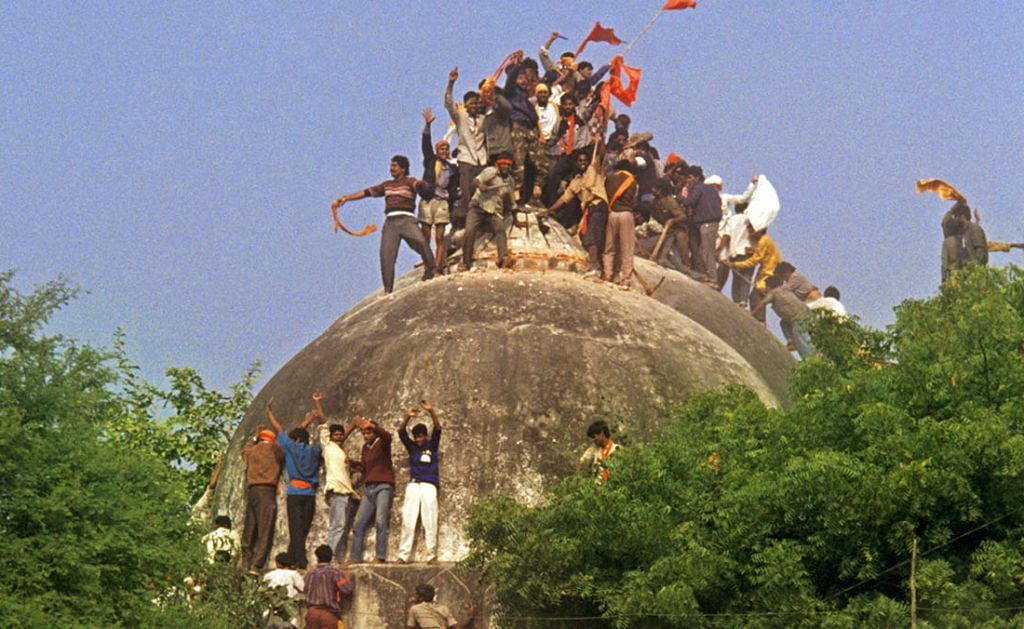Within a month or so of Babri demolition, all the damaged mosques in Ayodhya were restored to their original state.
Ayodhya burning. Arson. Rampaging mobs.
In this atmosphere riven with fear and rumour, I was summoned to Lucknow on the afternoon of 7 December, 1992 and told to rush to Faizabad to take charge as the district magistrate.
When I reached Lucknow from Allahabad (where I was posted then as a member of the board of revenue), bombs could be heard from even the inside of the secretariat building, where I was being briefed by then chief secretary V.K. Saxena. He asked me to immediately go and control the turbulent situation in Ayodhya.
Around 4 am, 8 December 1992, I left for Faizabad. Since the entire area was under curfew and the roads leading to Faizabad were blocked by Hindu kar sevaks, I reached by helicopter. An eerie and uneasy quiet defined the area. The administration had to urgently restrain the lumpen mobs who had run amok in the past week and openly threatened, what they termed as, “Babur’s progeny” to leave India.
Also read: The erasure of the Babri Masjid actually began six years before its demolition
Thousands of Muslim residents had fled Ayodhya in fear much before the demolition of the Babri Masjid. After the demolition, rampaging mobs had torched and ravaged Muslim homes and damaged mosques in the vicinity of the disputed Babri Masjid. Rule of law had been totally negated and the administration had been a mute spectator to the mayhem. The police had been accused of partisanship and had not stopped the mobs.
Who would trust the administration now? In this surcharged atmosphere, I began the vital task of restoring the primacy of law, to instil a sense of security among the people. Muslims who had fled the town were huddled in makeshift relief camps with dismal living conditions. Their misery was further aggravated by a fear that they would be hounded out from there as well. The prevailing public opinion was that these people would never be able to return to their homes. That the social fabric had been split forever.
I was determined to reverse this situation and re-establish public faith in this viciously polarised environment.
Not a single incident was allowed to disrupt peace thereafter and the explosive situation was contained. The facilities in the relief camps were immediately improved and safety restored. A stern message was conveyed to the miscreants. Our immediate efforts were to promote confidence amongst the minorities. Through intensive conversations, we succeeded in convincing the displaced Muslim families that the law and the state are with them. After a lot of persuasion and assurance, they agreed to return to their damaged homes. This was a big step forward.
We then conducted an honest survey of the loss they had suffered, promptly sanctioning and disbursing necessary rehabilitation and house-building grants that would enable the Muslims to rebuild their torched homes. Numerous local bodies and departments involved in the process, sought to obstruct and delay the rehabilitation process. Red-tapism was checked and hurdles removed.
Also read: A journalist recounts helping prime accused in Babri Masjid demolition sneak into Ayodhya
It wasn’t just the people, but even the landscape was scarred in the aftermath of the Babri Masjid demolition. The main road of Faizabad was dotted with many damaged mosques. I was determined to have these mosques repaired. Prominent leaders in the area were enlisted for this effort and I promised to provide necessary help. The Muslim community did not collaborate immediately because they didn’t have much hope for healing.
To me, the mosques embodied the secular ethos of our land enshrined in our Constitution. Damaging the mosques was an assault on the rich pluralistic heritage of Ayodhya. It had to be reclaimed. Repairing them was necessary to restore the confidence of the besieged minority.
Within a short span of a month or so, all the damaged mosques were restored to their original state. There was no reaction, no rioting. The spirit of accommodation prevailed. The composite heritage of the twin city of Faizabad-Ayodhya triumphed again.
Also read: Why Ayodhya cannot be resolved like Somnath temple
Simultaneously, we began attacking the real monsters – the evils of poverty, illiteracy, lack of basic health care, unemployment, which had grown under successive governments of every hue and colour. The populace also responded proactively. They were made aware that divine invocations through the Ram temple or Babri Masjid would not alleviate their misery. It was misgovernance, which had destroyed their lives. Development, not mandir-masjid became the defining agenda in politics for the first time after 1986. Communities began cooperating with each other as well as with the administration.
The author is a retired IAS officer and former secretary in the government of India.
